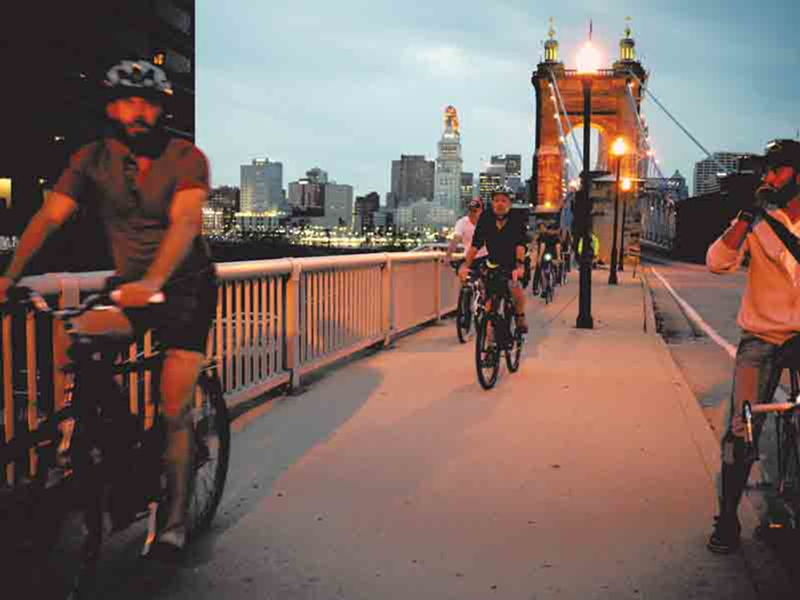M
ayor John Cranley’s sudden steering of Cincinnati’s bike plan off-street has forced cycling advocates and administrators to regroup and refocus their attempts to move the city in a more bike-friendly direction.
City Council last week passed modified ordinances altering the Central Parkway Bikeway Plan and refocusing $1.9 million for other projects, leaving local cyclists and cycling advocates to reassess the future of on-street biking infrastructure in a city that had made progress striping bike lanes and increasing visibility for cyclists in recent years. In the meantime, some council members have spoken out against seemingly hypocritical processes Cranley and Vice Mayor David Mann followed to get their way.
Before council actually passed the ordinances on April 30, the board of trustees of Queen City Bike, a nonprofit cycling advocacy group, responded to the pausing of the Central Parkway project by scheduling a meeting to explain a number of “difficult choices” it had to make in recent weeks.
“It is also very clear that our new administration and council will have a very different approach to bicycling than in years past,” read an email sent to supporters. “We need your help to help us plan for making Cincinnati the most bike and pedestrian friendly it can be in the future.”
Cranley spokesperson Kevin Osborne says funding bike trails isn’t a departure from the mayor’s stated intention to focus on trails over bike lanes on streets.
“It should not be a surprise to anyone; he mentioned it several times during his campaign,” Osborne says.
Cranley’s preference for trails doesn’t necessarily go completely against Cincinnati’s Bicycle Transportation Plan adopted in 2010 by the previous council, but it does veer away from the plan’s on-street emphasis. The first phase scheduled for completion in 2015 — the city is significantly behind — listed 91 miles of on-street infrastructure compared to 12 off-street miles. Cranley’s vision also goes against what the city has been working toward for the past few years as it constructed nearly 17 miles of on-street infrastructure compared to about five miles off-street.
Osborne says Cranley’s focus doesn’t hinder what Cincinnati’s bike plan is trying to achieve, nor does it go against expectations from cyclists and advocates — except a few.
Advocates, councilmembers and administrators are keeping mum about whether they disagree with Cranley as he shifts the focus of a bike plan already vulnerable because of a lack of funding. They tout any progress as positive.
“We’re weighing a lot of different needs in this scenario and we are grateful that we’re moving ahead with all of these great bicycle projects,” says Nern Ostendorf, executive director of Queen City Bike.
At City Council’s April 30 meeting, Cranley shed light on his position as a policymaker moving forward.
“I happen to believe based on campaigning and talking to residents and grassroots activists that there’s a great deal of support behind the four bike trails that are listed in this ordinance,” Cranley said. “I do think it’s important that the policy makers and those of us elected — all of us are elected — set the policy and not constantly wake up and find that priorities have been set not by the elected official, but by someone else, administrators who may or may not have and be completely in tune with the priorities of the neighbors and residents that I talk to on a regular basis who have a clear overwhelming support for trails and bike share but are less overwhelming in their support for bike lanes.”
Cranley mentioned several times “waking up” to find construction of the Delta Avenue Restriping Project underway as a way to hammer his point that council should be directly involved in such policymaking, though a page dedicated to the restriping project’s progress on the Department of Transportation and Engineering website clearly states that construction was expected to begin in spring of 2014.
Cranley’s statements came during discussion of a Cincy Bike Share ordinance he crafted which focuses $1.9 million of bike program funds toward Cincy Bike Share ($1.1 million) and four other bike trail projects in various stages of development at $200,000 each.
Cranley pushed it through for a vote at last week’s meeting despite insistence from councilmembers Yvette Simpson, Chris Seelbach and P.G. Sittenfeld that it be tabled for at least a week so council could understand the complete ramifications on existing projects caused by shifting funds toward the bike trail projects.
“I think this needs to be really vetted in a committee before we can prioritize these four trails,” Seelbach said.
Seelbach asked to split the ordinance so council could move forward with Bike Share and revisit the four bike trails, but Cranley wouldn’t budge.
“The same people who have been fighting to pause and stop and ask questions, I’m just asking for the exact same respect,” Seelbach said. “I mean, we just found out about this last week, we just found out new information about it today. There’s no rush — give us a week or two so we can have a full hearing.”
A motion pushed forward by Sittenfeld to delay the ordinance at Cranley’s reluctance failed by a 4-5 vote. Council then voted — without knowing the ramifications — 7-2 in favor of the Bike Share program, which sent a clear political statement: Cranley is focused toward bike trails and the Department of Transportation and Engineering (DOTE) doesn’t decide how to spend money; council does.
DOTE Director Michael Moore wasn’t sure Friday what the ramifications to other projects were going to be, but during a subsequent conversation on Monday said the only project affected will be the Salem to Sutton portion of the Ohio River Trail, which will have to be cut into segments.
Cranley’s office says the funding wasn’t previously allocated toward any projects, and Moore says it was left over from completed projects that the department accumulated to have a reserve for future and current projects. The $1.9 million relegated to the ordinance is about quadruple the annual biking transportation budget, Moore says. Moore wouldn’t elaborate as to the percentage $1.9 million represents of the money DOTE has to work on its projects.
“Those monies do a whole host of things,” Moore says.
Moore listed Delta Avenue and Wolper Avenue projects, bike rings and bike month support, but he insists dedicating the $1.9 million will not impede any of the department’s current projects.
“Council’s got a priority that we want to advance the Bike Share program more quickly,” Moore says. “We can adjust those reserves.”
The money, however, is also used to match project grants with matching fund requirements.
“Some of it are dollars that have not been spent pending anticipation of things going forward,” Moore says.
The $1.1 million dedicated to Cincy Bike Share accounts for nearly all of the program’s $1.275 million first-year capital and launch costs, which will establish 21 bike stations in downtown and Over-the-Rhine. Cranley insisted it be pushed forward so bike share could receive matching funds, even though a 2012 Bike Share feasibility study prepared for the city says “very few cities have used local public funding for the initial deployment of bike sharing, although some cities have provided smaller ‘match’ amounts as a show of support.” Instead, cities generally use state or federal public funds and rely on sponsorship or advertising to launch such programs, but those sources have been “tapped out” in Cincinnati due to the streetcar project, according to the study. The study suggests diverting a portion of parking revenue, bus bike rack advertising and vehicle registration funds in addition to the private sector opportunities.
It’s still unclear how far the $200,000 allocated to four different bike trails — Wasson Way, Oasis Bike Trail, Mill Creek Bike Trail and Ohio River Trail West — will carry them. Each are in different phases. For instance, the Wasson Way project still needs a lot of coordination before construction can begin on the 6.5-mile path connecting Xavier University to the Little Miami Bike Trail in Newtown. It’s estimated the project will cost $1.1 million per mile. Bike trails tend to be significantly more expensive than on-street infrastructure since major construction isn’t normally contracted for on-street projects. ©






